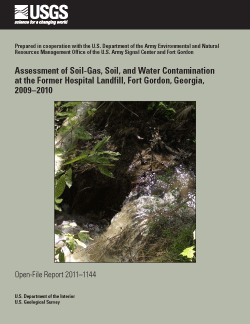Open-File Report 2011–1144

ABSTRACTSoil gas, soil, and water were assessed for organic and inorganic constituents at the former hospital landfill located in a 75-acre study area near the Dwight D. Eisenhower Army Medical Center, Fort Gordon, Georgia, from April to September 2010. Passive soil-gas samplers were analyzed to evaluate organic constituents in the hyporheic zone of a creek adjacent to the landfill and soil gas within the estimated boundaries of the former landfill. Soil and water samples were analyzed to evaluate inorganic constituents in soil samples, and organic and inorganic constituents in the surface water of a creek adjacent to the landfill, respectively. This assessment was conducted to provide environmental constituent data to Fort Gordon pursuant to requirements of the Resource Conservation and Recovery Act Part B Hazardous Waste Permit process. Results from the hyporheic-zone assessment in the unnamed tributary adjacent to the study area indicated that total petroleum hydrocarbons and octane were the most frequently detected organic compounds in groundwater beneath the creek bed. The highest concentrations for these compounds were detected in the upstream samplers of the hyporheic-zone study area. The effort to delineate landfill activity in the study area focused on the western 14 acres of the 75-acre study area where the hyporheic-zone study identified the highest concentrations of organic compounds. This also is the part of the study area where a debris field also was identified in the southern part of the 14 acres. The southern part of this 14-acre study area, including the debris field, is steeper and not as heavily wooded, compared to the central and northern parts. Fifty-two soil-gas samplers were used for the July 2010 soil-gas survey in the 14-acre study area and mostly detected total petroleum hydrocarbons, and gasoline and diesel compounds. The highest soil-gas masses for total petroleum hydrocarbons, diesel compounds, and the only valid detection of perchloroethene were in the southern part of the study area to the west of the debris field. However, all other detections of total petroleum hydrocarbons greater than 10 micrograms and diesel greater than 0.04 micrograms, and all detections of the combined mass of benzene, toluene, ethylbenzene, and xylene were found down slope from the debris field in the central and northern parts of the study area. Five soil-gas samplers were deployed and recovered from September 16 to 22, 2010, and were analyzed for organic compounds classified as chemical agents or explosives. Chloroacetophenones (a tear gas component) were the only compounds detected above a method detection level and were detected at the same location as the highest total petroleum hydrocarbons and diesel detections in the southern part of the 14-acre study area. Composite soil samples collected at five locations were analyzed for 35 inorganic constituents. None of the inorganic constituents exceeded the regional screening levels. One surface-water sample collected in the western end of the hyporheic-zone study area had a trichlorofluoromethane concentration above the laboratory reporting level and estimated concentrations of chloroform, fluoranthene, and isophorone below laboratory reporting levels. |
First posted August 22, 2011 For additional information contact: Part or all of this report is presented in Portable Document Format (PDF); the latest version of Adobe Reader or similar software is required to view it. Download the latest version of Adobe Reader, free of charge. |
Falls, W.F., Caldwell, A.W., Guimaraes, W.B., Ratliff, W.H., Wellborn, J.B., and Landmeyer, J.E., 2011, Assessment of soil-gas, soil, and water contamination at the former hospital landfill, Fort Gordon, Georgia, 2009–2010: U.S. Geological Survey Open-File Report 2011–1144, 35 p.
Abstract
Introduction
Purpose and Scope
Description of the Study Area
Methods
Hyporheic-Zone and Soil-Gas Samplers
Soil Samples
Surface-Water Samples
Results
Hyporheic-Zone Samplers
Soil-Gas Samplers: July 26–30, 2010
Soil-Gas Samplers: September 16–22, 2010
Soil Samples
Surface-Water Samples
Summary
References Cited